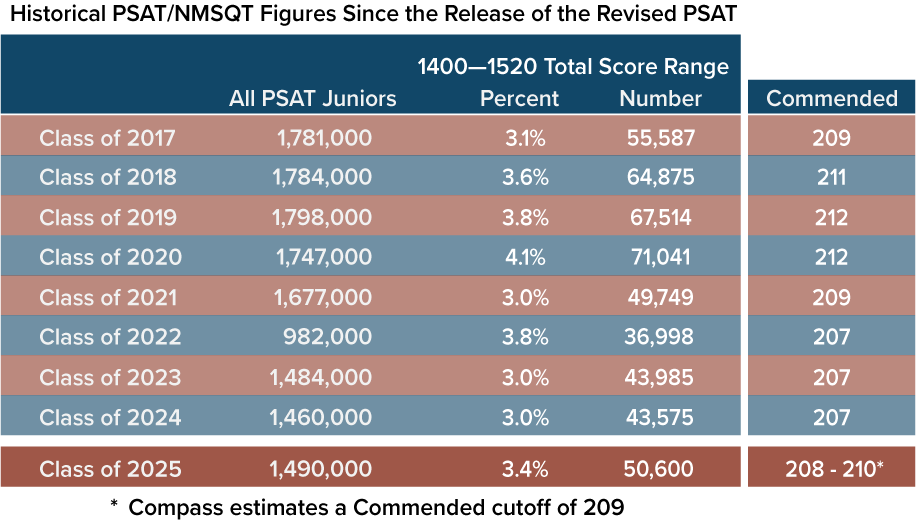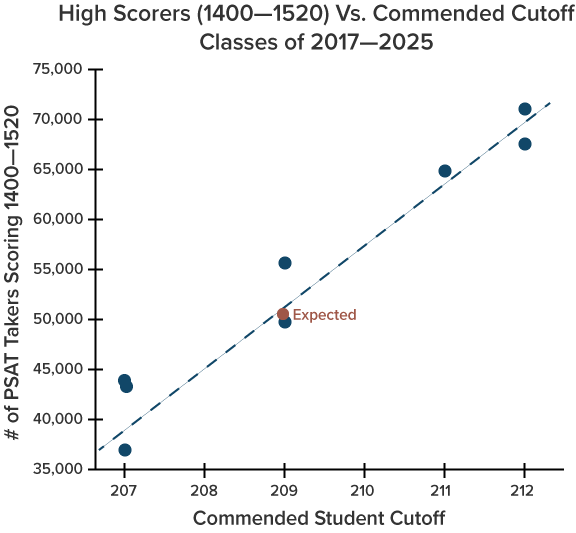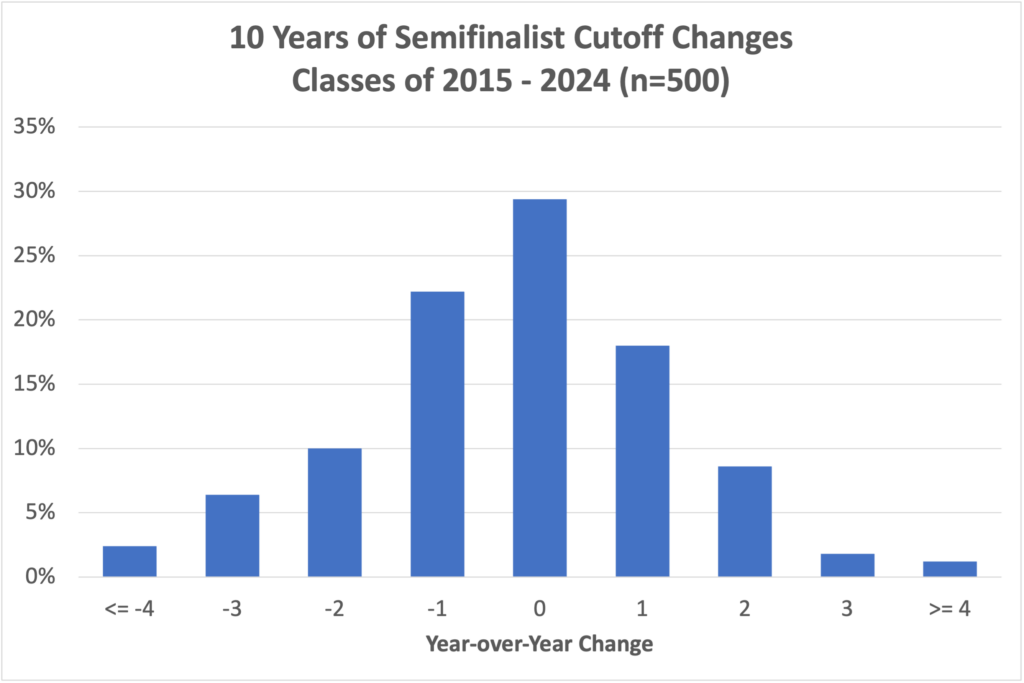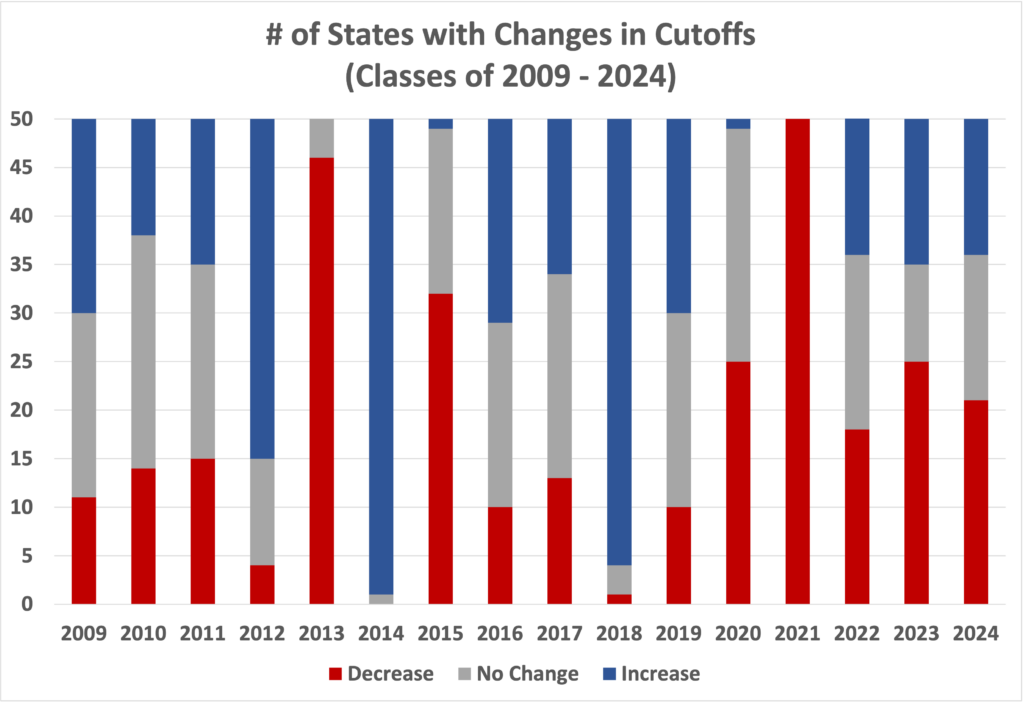By Art Sawyer
Breaking News: We now have the results from all of the 1,490,000 juniors who took the October 2023 PSAT and have updated our estimates accordingly.
Compass Co-founder Adam Ingersoll hosted a strategy session that helped students interpret their official PSAT results and craft a smart path forward. He shared our latest insights and updated forecasts as the role of testing steadily regains significance in competitive contexts.
The 2023 digital PSAT/NMSQT for the class of 2025 represents the biggest change to the National Merit Scholarship Program since the PSAT was overhauled in 2015. Each year Compass looks at the results from the PSAT and tracks projected Selection Index cutoffs for Commended Students and for Semifinalist in each of the 50 states. [See National Merit Scholarship Program Explained for full details on stages and instructions. For information on the class of 2024 cutoffs, see this archive.]
Instead of having schools administer a paper test on fixed dates, College Board allowed the digital PSAT to be offered throughout October. College Board also introduced a new score return policy. Students taking the test on or before October 14th receive scores on November 6th. Students taking the PSAT after October 14th receive their scores on November 16th. Compass now has the data from both release windows. Approximately 50,000 students landed in the 1400-1520 score band from almost 1.5 million test takers. The initial half of scores already accounted for 30,000 of top band scores, so the later testers had a lower proportion of high scorers. This will come as a relief to students who were fearing an extremely large jump in Selection Index cutoffs.
This year is shaping up similar to the class of 2021 (the last pre-pandemic PSAT) and, reaching back farther, the class of 2017.
The number of top scorers is the most critical piece of information that we get this early in the process. There is a strong correlation between the 1400-1520 band of students and the Commended Student score.
The Commended Student cutoff is likely to rise to 209 (above the 207 from the last 3 years). Estimates can be imperfect, but we are confident that the Commended cutoff will fall within the 208 to 210 range. The higher Commended cutoff, in turn, correlates with higher Semifinalist cutoffs. Below are those estimates.
[See Compass’s National Merit Historical Cutoffs post for data going back to the class of 2008, which can be helpful in comparing this year to its analogues.]
The shift to a shorter, online and adaptive exam is unlikely to wreak the havoc we saw when the “revised PSAT” was introduced 8 years ago. That test overhauled content AND scoring. The digital SAT represents a content change — mainly on Reading and Writing — but keeps the 320-1520 score range intact. The Selection Index, too, remains consistent, with the Reading and Writing score having twice the weight of the Math score.
However, for any given state, a change in cutoff is more likely than not. Historically, Semifinalist cutoffs remain unchanged only about one-third of the time.
Even in years where the Commended cutoff remains static, we see half of state cutoffs go up or down. And it is extremely improbable that the Selection Index will be static. The chart below divides the 50 states into those that saw increases (blue), those that remained unchanged (gray), and those that saw declines (red). We are likely to see a year with far more blue than gray and more gray than red.
Uncertainty around exactly which state cutoffs will change and by how much is why we encourage students to compare their scores to the full estimated range in the table above rather than to a single value (our “Most Likely”). These estimates are built from prior performance data and from data on what scores are doing nationally. State and national numbers are not always in alignment. Cutoffs are particularly bumpy in states with smaller pools of test takers and National Merit Semifinalists. Over the last 10 years, large states’ cutoffs have remained within 1 point of the prior cutoff 88% of the time. That figure drops to 73% for midsized states and 53% for small states. No large state’s cutoff has jumped by more than 3 points in a year, whereas 6-point changes have occurred in the pool of smaller states. Scores also tend to be more stable as they get higher. It is more unusual for a state to move from 221 to 222, for example, than for a state to move from 212 to 213.
What does a cutoff mean? Do I need to score at the cutoff or above it?
Students must have a Selection Index at or above the official cutoff in order to qualify for National Merit honors.
The top 52,000 to 54,000 students will receive some form of honors. National Merit Scholarship Corporation (NMSC) determines the cutoff number that comes closest to producing the target number of national honorees. This is the Commended cutoff.
How are Semifinalist cutoffs set?
Unlike the national Commended cutoff, Semifinalist cutoffs are
calculated state by state. NMSC allocates the 16,000 semifinalists among
states based on the annual number of high school graduates. For
example, California sees about 2,000 Semifinalists every year, Michigan
500, and Wyoming 25. In each state, NMSC determines the Selection Index
that comes closest to matching its target number of Semifinalists. If
1,900 California students score 222 and higher and 2,050 score 221 or
higher, then the Semifinalist cutoff would be 221 (this assumes that the
target is exactly 2,000). Because score levels can get crowded, it is
easy for cutoffs to move up or down a point even when there is minimal
change in testing behavior or performance.
No Semifinalist cutoff can be lower than the national Commended level. Cutoffs for the District of Columbia and for U.S. students studying abroad are set at the highest state cutoff (typically New Jersey). The cutoff for students in U.S. territories and possessions falls at the Commended level each year. Boarding schools are grouped by region. The cutoff for a given region is the highest state cutoff within the region.
Why does the number of top scorers vary from year to year?
While there are changes in the number of students taking the PSAT/NMSQT,
there can also be small flaws in test scaling that play a role. Prior
to the digital PSAT, a single test form was seen by a large percentage
of test takers. Something amiss with that single form could impact
selection cutoffs across the country. The digital PSAT is constructed
differently. Students receive unique form codes drawn from a large pool
of problems. Scaled scores are generated based on the characteristics of
those problems. In theory, this should make scores more stable. College
Board’s early studies have found an extremely high correlation between
the paper-and-pencil test and digital test. Still, even with its
adaptive nature, the uncertainty remains as to whether the much shorter
test can reliably score students at the 700-760 end of the scale. It
appears that the class of 2025 is roughly average compared to the
classes of 2017 to 2024 (the years after the change from the 2400 to
1520 scale).
Will test cancellations raise or lower qualifying scores for the National Merit Scholarship Program?
College Board’s online systems failed under load on one of the biggest
testing days. There was also a bug that prevented iPads on the latest
operating system from submitting exams. We do not know how many schools
or students simply gave up and did not retest on rescheduled dates. If
the cancellations increase the number of students pursuing alternate
entry (see Compass’s explanation of National Merit alternate entry)
then cutoffs could rise. Alternate entrants tend to have higher scores,
because they can submit SAT scores through June 2024 to enter the
competition. They must apply by April.
When are National Merit Semifinalists announced?
The Commended cutoff becomes unofficially known by the end of April. The
lists of Semifinalists are not distributed to high schools until the
end of August. NMSC sets a press embargo on Semifinalist announcement
until mid-September, but schools are allowed to notify students before
that date. NMSC does not send Commended Student letters to high schools
until mid-September. Compass will keep students updated on developments
as those dates approach.
Do state and national percentiles indicate whether I will be a National Merit Semifinalist?
No! Approximately 1% of test takers qualify as Semifinalists each year,
so it is tempting to view a 99th percentile score as indicating a high
enough score — especially now that College Board provides students with
percentiles by state. There are any number of flaws that rule out using
percentiles as a quick way of determining National Merit status.
- Percentiles are based on section scores or total score, not Selection Index
- Percentiles are rounded. There is a large difference, from a National Merit perspective, between the top 0.51% and the top 1.49%
- Percentiles reveal the percentage of students at or below a certain score, but the “at” part is important when NMSC is determining cutoffs.
- The number of Semifinalists is based on the number of high school graduates in a state, not the number of PSAT takers. Percentiles are based on PSAT takers. States have widely varying participation rates.
- Most definitive of all: Percentiles do not reflect the current year’s scores! They are based on the prior 3 years’ performance. They are set even before the test is given. And if you are going to use prior history, why not use the completely accurate record of prior National Merit cutoffs rather than the highly suspect percentiles?
Entry requirements for National Merit versus qualifying for National Merit.
Your PSAT/NMSQT score report tells you whether you meet the eligibility
requirements for the NMSP. In general, juniors taking the October PSAT
are eligible. If you have an asterisk next to your Selection Index, it
means that your answers to the entrance questions have made you
ineligible. Your answers are conveniently noted on your score report. If
you think there is an error, you will also find instructions on how to
contact NMSC. Meeting the eligibility requirements simply means that
your score will be considered. Approximately 1.4 million students enter
the competition each year. Only about 52,000 students will be named as
Commended Students, Semifinalists, Finalists, or Scholars. See National Merit Explained for more information.






No comments:
Post a Comment